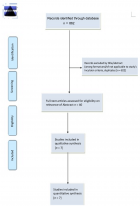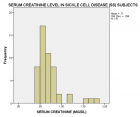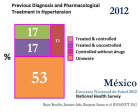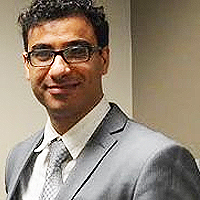Abstract
Mini Review
Joint Functional Screening for Older Adults: Clinical Prevention of Accidental Fall
Balwant S Bains*
Published: 27 September, 2017 | Volume 2 - Issue 3 | Pages: 091-094
As people get older, chronic diseases become an important reason of disability while a decline in physical functions is related to aging among the elders, which may lead to dependency and isolation of the older adults. Body asymmetry and imbalance body alignment can bring added stress to the joint structures that can cause dysfunction of the joint, ligaments, tendons, bursas, and related muscles, which in return brings about problem while walking or during activities of daily living. Joint Functional Screening (JFS) is a systemic clinical examination with clinical reasoning of the entire human joints body, with or without causative limitation to derive a holistic analysis of musculoskeletal system. JFS profile helps to assess body disorder of older people. This clinical screening include documentation of balance of the body, lower and upper body strength, joints flexibility, body composition, and body alignment. This is an innovation build to profile a normal musculoskeletal state to decode any anomaly in an otherwise a normal subject, who might be preparing to take up any activities in one’s lifespan that could elicit an injury which could be prevented. JFS could be a useful tool for physiotherapists, exercise therapist or even the personal trainers to screen a body prior to rehabilitative or an exercise program; and this clinical screening is presently a best guidance to prevent risk of fall or injury among individual healthy people and older adult.
Read Full Article HTML DOI: 10.29328/journal.jsmt.1001013 Cite this Article Read Full Article PDF
Keywords:
Joint Functional Screening for Older Adults, Clinical Prevention of Accidental Fall
References
- Harper S. The Challenges of Twenty-First-Century Demography. Challenges of Aging: Springer. 2015; 17-29. Ref.: https://goo.gl/X6dXDe
- Mosavat M, Mirsanjari M, Omar SZ, Sadeghi H. Bone Health, Exercise and Nutrition. J Adv & Appl Sci. 2014; 2: 143-156. Ref.: https://goo.gl/apcQ9e
- Chen H, Zhou X, Fujita H, Onozuka M, Kubo KY. Age-related changes in trabecular and cortical bone microstructure. Int j endocrinol. 2013; 2013: 213234. Ref.: https://goo.gl/ZL7z5s
- Sadeghi H, Hakim MN, Hamid TA, Amri SB, Razeghi M, et al. The effect of exergaming on knee proprioception in older men: A randomized controlled trial. Arch Gerontol Geriatrics. 2017; 69: 144-150. Ref.: https://goo.gl/HMZCkC
- Thiamwong L, Suwanno J. Effects of Simple Balance Training on Balance Performance and Fear of Falling in Rural Older Adults. Int J Gerontol. 2014; 8: 143-146. Ref.: https://goo.gl/wDGdm7
- Kosma M, Hondzinski JM, Buchanan DR. Exercise, Health, and Falls Risks among Older African American Women. Int J Kinesiol Sports Sci. 2017; 5: 16-27. Ref.: https://goo.gl/5cSkg8
- Shakoor E, Jahromi MK, Salesi M, Sadeghi H. The Effects of 10 Weeks Concurrent Aerobic and Strength Exercise on Quality of Life and Resilience of Kidney Transplant Patients. Int J Appl Exercise Physiol. 2015; 4: 1-8. Ref.: https://goo.gl/WBSGZp
- Zheng XY, Han S, Wang LM, Zhu YH, Zeng L, et al. Quality of Life and Psychology After Living-related Kidney Transplantation From Donors and Recipients in China. Transplantation proceedings. 2014; 46: 3426-3430. Ref.: https://goo.gl/bEQDZU
- Quinn T, McArthur K, Ellis G, Stott D. Functional assessment in older people. BMJ. 2011; 343: 469-473. Ref.: https://goo.gl/HHSWwg
- Ellis G, Whitehead MA, Robinson D, O’Neill D, Langhorne P. Comprehensive geriatric assessment for older adults admitted to hospital: meta-analysis of randomised controlled trials. Bmj. 2011; 343: 6553. Ref.: https://goo.gl/NyDa5M
- Mitchell UH, Johnson AW, Vehrs PR, Feland JB, Hilton SC. Performance on the Functional Movement Screen in older active adults. J Sport and Health Sci. 2016; 5: 119-125. Ref.: https://goo.gl/sZAkgf
- Yamada M, Aoyama T, Nakamura M, Tanaka B, Nagai K, et al. The reliability and preliminary validity of game-based fall risk assessment in community-dwelling older adults. Geriatric nursing (New York, NY). 2011; 32: 188-194. Ref.: https://goo.gl/rqYtzp
- Inouye SK, Brown CJ, Tinetti ME. Medicare nonpayment, hospital falls, and unintended consequences. New England Journal of Medicine. 2009; 360: 2390-2393. Ref.: https://goo.gl/gX8xtR
- Sadeghi H, Shariat A, Asadmanesh E, Mosavat M. The Effects of core stability Exercise on the dynamic balance of volleyball players. Int J Appl Exercise Physiol. 2013; 2: 1-10. Ref.: https://goo.gl/iTFpjv
- Moreland JD, Richardson JA, Goldsmith CH, Clase CM. Muscle weakness and falls in older adults: a systematic review and meta‐analysis. J American Geriatrics Society. 2004; 52: 1121-1129. Ref.: https://goo.gl/qiVk6j
- LaRoche DP, Cook SB, Mackala K. Strength asymmetry increases gait asymmetry and variability in older women. Medicine and science in sports and exercise. 2012; 44: 2172. Ref.: https://goo.gl/oQLnAn
- Chiacchiero M, Dresely B, Silva U, DeLosReyes R, Vorik B. The relationship between range of movement, flexibility, and balance in the elderly. Topics in Geriatric Rehabilitation. 2010; 26:148-155. Ref.: https://goo.gl/h4i6gx
- Fjeldstad C, Fjeldstad AS, Acree LS, Nickel KJ, Gardner AW. The influence of obesity on falls and quality of life. Dynamic Medicine. 2008; 7: 4. Ref.: https://goo.gl/jZo4Ra
Similar Articles
Recently Viewed
-
Environmental Factors Affecting the Concentration of DNA in Blood and Saliva Stains: A ReviewDivya Khorwal*, GK Mathur, Umema Ahmed, SS Daga. Environmental Factors Affecting the Concentration of DNA in Blood and Saliva Stains: A Review. J Forensic Sci Res. 2024: doi: 10.29328/journal.jfsr.1001057; 8: 009-015
-
Markov Chains of Molecular Processes of Biochemical MaterialsOrchidea Maria Lecian*. Markov Chains of Molecular Processes of Biochemical Materials. Int J Phys Res Appl. 2024: doi: 10.29328/journal.ijpra.1001076; 7: 001-005
-
Generation of Curved Spacetime in Quantum FieldSarfraj Khan*. Generation of Curved Spacetime in Quantum Field. Int J Phys Res Appl. 2024: doi: 10.29328/journal.ijpra.1001077; 7: 006-009
-
Optimizing Milk Safety: Applying Nuclear Techniques in X-ray Fluorescence Spectroscopy for Heavy Metal Quantification in Powdered Milk Consumed in SenegalPapa Macoumba Faye*, Djicknack Dione, Oumar Ndiaye, Moussa Hamady SY, Nogaye Ndiaye, Alassane Traore, Ababacar Sadikhe Ndao. Optimizing Milk Safety: Applying Nuclear Techniques in X-ray Fluorescence Spectroscopy for Heavy Metal Quantification in Powdered Milk Consumed in Senegal. Int J Phys Res Appl. 2024: doi: 10.29328/journal.ijpra.1001078; 7: 010-015
-
Thermoelectric Materials Based on Lead Telluride and Prospects for their Practical ApplicationYuriy Pavlovskyy*, Nadiya Pavlovska. Thermoelectric Materials Based on Lead Telluride and Prospects for their Practical Application. Int J Phys Res Appl. 2024: doi: 10.29328/journal.ijpra.1001079; 7: 016-018
Most Viewed
-
Evaluation of Biostimulants Based on Recovered Protein Hydrolysates from Animal By-products as Plant Growth EnhancersH Pérez-Aguilar*, M Lacruz-Asaro, F Arán-Ais. Evaluation of Biostimulants Based on Recovered Protein Hydrolysates from Animal By-products as Plant Growth Enhancers. J Plant Sci Phytopathol. 2023 doi: 10.29328/journal.jpsp.1001104; 7: 042-047
-
Sinonasal Myxoma Extending into the Orbit in a 4-Year Old: A Case PresentationJulian A Purrinos*, Ramzi Younis. Sinonasal Myxoma Extending into the Orbit in a 4-Year Old: A Case Presentation. Arch Case Rep. 2024 doi: 10.29328/journal.acr.1001099; 8: 075-077
-
Feasibility study of magnetic sensing for detecting single-neuron action potentialsDenis Tonini,Kai Wu,Renata Saha,Jian-Ping Wang*. Feasibility study of magnetic sensing for detecting single-neuron action potentials. Ann Biomed Sci Eng. 2022 doi: 10.29328/journal.abse.1001018; 6: 019-029
-
Pediatric Dysgerminoma: Unveiling a Rare Ovarian TumorFaten Limaiem*, Khalil Saffar, Ahmed Halouani. Pediatric Dysgerminoma: Unveiling a Rare Ovarian Tumor. Arch Case Rep. 2024 doi: 10.29328/journal.acr.1001087; 8: 010-013
-
Physical activity can change the physiological and psychological circumstances during COVID-19 pandemic: A narrative reviewKhashayar Maroufi*. Physical activity can change the physiological and psychological circumstances during COVID-19 pandemic: A narrative review. J Sports Med Ther. 2021 doi: 10.29328/journal.jsmt.1001051; 6: 001-007

HSPI: We're glad you're here. Please click "create a new Query" if you are a new visitor to our website and need further information from us.
If you are already a member of our network and need to keep track of any developments regarding a question you have already submitted, click "take me to my Query."


















































































































































